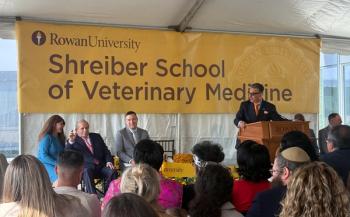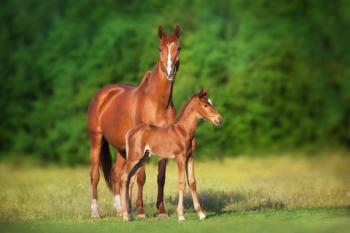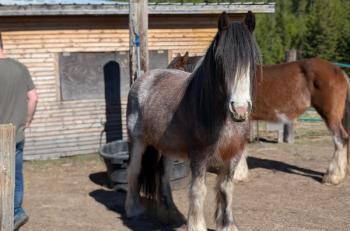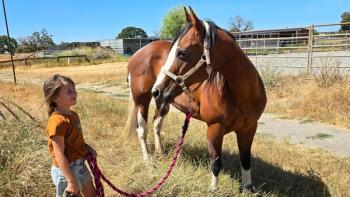
Comeback: The art and science of equine rehabilitation
New studies show rehab can get horses back to health even more quickly than previously thought.
Successfully returning to an elite level in sports after a major injury is considered so difficult that awards are given to those who accomplish this feat. The "comeback athlete of the year" typically has suffered an injury or been affected by a disease process and traversed a long and difficult road to recovery before regaining previous levels of skill and ability.
The developing field of rehabilitative medicine, for both people and horses, focuses on managing that path to recovery and helping athletes heal so their eventual return to activity is optimized. The equine athlete seems to be especially adept at healing and returning to function after serious injury or traumatic events.
Indeed, better postoperative monitoring, improved communication between surgeon and client and better surgical handling of incisions can all lead to quicker healing and more complete comebacks among horses.
A recent study revealed that most horses (86.1%) were able to return to sporting activities after a major surgical procedure and, even more interestingly, 83.5% returned to their former level of competition or higher.1
Timing is important
One aspect of equine rehabilitation that has potentially been underdeveloped is the timing of return to athletic activity. Bringing a horse back after surgery has always been a balancing act between necessary healing and repair and the need to get the athlete back in the game. A concern for the horse's welfare has been counterbalanced by the economic realities of the athlete's job as a racehorse, jumper, dressage competitor or other sporting participant.
Veterinary surgeons have traditionally adopted a conservative postoperative rehabilitation program. These recommendations, however, may not necessarily reflect the most up-to-date scientific information, and more aggressive yet medically safe rehabilitation programs may be able to get horses to come back to athletic activity even more quickly.
Colic is still the most common reason for major surgical intervention in horses, and the traditional rehabilitation recommendations for a horse after colic surgery have changed only minimally during the past few decades. The standard program calls for owners and trainers to keep their recovering horses on stall rest for the first 30 days, followed by 30 days of hand walking, leading to a final 30 days of turnout in a small paddock.
"The need to standardize postoperative care has developed for good reason," says John Peroni, DVM, Dipl. ACVS, an equine surgeon in the Department of Large Animal Medicine at the University of Georgia. "Surgeons and clinicians have averaged out their postoperative recommendations in order to minimize the complication rate while maximizing efficiency and functional restoration for the equine athlete."
The American College of Veterinary Surgeons website (
Many surgeons adhere to this basic three-month program because it's conservative, safe and easy. "In doing so," Peroni says, "we tend to lose sight of individual variations (in incisional healing) that may enable us to better tailor postoperative care and return to work for our horses."
Tendon, ligament rehabilitation
Rehabilitation of tendons and ligaments can take even longer because of the specialized physiology of these tissues. A poorer blood supply and slowed pattern of fiber regrowth can keep a horse from returning to athletic use for many months (conservatively, six to eight months) after injury to these structures. New technologies, such as stem cell injections, the use of platelet-rich plasma, shock wave therapy and others, can help shorten the healing time in some cases.
Established research has shown that tendons and ligaments heal more rapidly and with a stronger, more correct fiber pattern when low-level loading stress is applied to these recovering tissues. Consequently, hand walking is usually encouraged early in the rehabilitation process. But overly aggressive exercise can be detrimental, and reinjury of tendons and ligaments is often worse and more lasting than the initial damage.
The key to bringing these injured athletes back more quickly is being able to determine which horses are healing well and can safely be pushed to the next stage and which horses aren't progressing and should be maintained at present activity. Ultrasonographic and thermographic monitoring of tendon and ligament repair can help owners and trainers with their decisions. Ultrasonography will show changes in healing fiber patterns and an increase or measurable decrease in fluid within a tendon or ligament.
Tracy Turner, DVM, Dipl. ACVS, an equine surgeon and pioneer in the use of infrared imaging in the horse, notes, "Thermography has been shown to indicate inflammation and trauma to tendons and ligaments nearly two weeks before such lesions are detectable with ultrasound. Using thermography to monitor the rehabilitative phase of soft tissue healing also makes sense because this very sensitive modality provides the clinician with a means of quantifying the stage of repair and then making the appropriate rehab decisions."
The removal of guesswork from tendon and ligament healing assessment translates into more aggressive but more correct rehabilitation and a quicker return to function.
Joint repair
Equine joints are often damaged and require surgical repair. The intense forces placed on the joints of equine athletes generally dictate that longer time be spent on rehabilitation. The exact nature of joint damage is sometimes unknown, and the types of trauma are so varied that each joint rehabilitation case should be looked at individually, and postsurgical exercise programs also should be unique.
Consistent monitoring with a number of modalities and the correct application of pressure and range-of-motion exercises based on that monitoring will help shorten healing time in these types of injuries as well. Yet the question remains: Exactly how hard can we push the rehabilitative process in a healing horse?
Stuck in the past?
There seems to be little scientific evidence to back up the rehabilitation programs currently advocated. Rehabilitative recommendations appear to be based more on tradition, past policies and safe, perhaps overly conservative thinking rather than on research and current knowledge. Some excellent recent data suggest that a different, more accelerated approach to getting postsurgical horses back to activity is reasonable, yet many clinics and equine hospitals still advocate 30 days of stall rest, 30 days of hand walking and controlled hand grazing and 30 days of small pasture turnout before resuming work.
While certainly no one is in favor of pushing horses into work too early, and each case is individual, aggressive postsurgical rehabilitation is realistic for some horses and may make it possible for a safe, earlier return to competition.
Anthony Blikslager, DVM, PhD, Dipl. ACVS, professor of equine surgery at North Carolina State University, says, "The critical problem is that horses laid up after surgery begin to lose muscle strength, cardiovascular endurance and the ability to perform athletically at an increasing heart rate." The longer the period of inactivity, he says, the longer it will take for the horse to come back.
Case study: Colic surgery
A colic surgery repair is often largely determined by the condition and healing of the ventral midline incision. There's some confusion and disagreement as to an abdominal incision's healing strength and the time needed to arrive at a safe point for physical activity. Surgeons generally cite the weakness of the abdominal incision as the main reason for disallowing turnout or even a return to controlled athletic activity. Excessive motion or stretching of the abdominal incision, goes the standard thought on the issue, will result in damage to the abdominal repair, the horse's body wall or both, with infection, herniation or failure of wound closure as possible complications.
Some surgeons take this concern for the ventral midline incision to the extreme. Postoperative colic rehabilitation recommendations from the Philip Leverhulme Equine Hospital at the University of Liverpool in Great Britain advocate a conservative return to athletic function of well more than three months, stating, "All equine abdominal incisions are very slow to heal. Research shows that even one year after such an incision, the body wall has regained only 80% of its original strength."3
Discharge instructions from that institution further explain that "any exercise that prematurely increases strain on the incision (e.g., bucking, rearing, galloping across a field) increases the risk of a hernia forming at the surgical site."3
More recent studies, however, directly oppose this extended healing idea. These studies don't support a conservative healing time frame and actually suggest horses may in fact be able to return to athletic work much sooner. For example, a recent study on the tissue strength of the linea alba showed that "an uncomplicated abdominal incision regained tissue strength comparable with preoperative strength in as early as eight weeks after a ventral midline celiotomy."4
This study showed that surgeons could greatly influence the postoperative healing of colic surgery by their choice of suture material, suture pattern and surgical technique.
Peroni agrees and further suggests, "The amount of trauma and handling the abdominal wall undergoes during the actual surgery is probably correlative to the healing process of the incision as well."
If the surgeon must stretch and handle the edges of the incision excessively by taking intestines out and then repacking them in the belly, or by prolonged deep palpation through the incisional opening, then that incision may experience more swelling and will therefore take longer to heal. Such a horse may not return to work in eight weeks. However, a horse with uncomplicated colic surgery and a minimally traumatized incision may be fully repaired in six to eight weeks.
The linea alba study discussed above states, "Based on our observations, there is a valid scientific argument for returning horses to controlled exercise at 60 days postoperatively."4
To achieve this more aggressive return to athletic function after colic surgery, without placing the equine athlete at risk, most veterinary surgeons agree that improved communications and crucial rechecks are imperative.
Says Blikslager, "Close communication between the surgeon and the owner or trainer at the time of discharge can be very helpful in structuring the lay-up period and the time wframe for a return to exercise."
Adds Peroni, "A conversation with the surgeon focusing on an assessment of the relative stress the abdominal incision underwent during surgery and recovery would be crucial to the development of a more rapid but successful rehab program."
The most important time would be at the six-to-eight-week period, as incisions have healed but the horse still can benefit from a slow return to exercise to put some light strain on the incision and increase its strength. Good healing in an uncomplicated case, on the other hand, would be a signal to a trainer to step up rehabilitation. Such a horse may be doing light work at six weeks and be back in a regular program at eight weeks.
The last few weeks of the rehabilitation program can essentially be looked at as the first few weeks of a conditioning program, thereby shortening the overall time for comeback and making a well-healed horse ready for competition sooner.
Dr. Marcella is an equine practitioner in Canton, Ga.
References
1. Christophersen MT, Tnibar A, Pihl TH, et al. Sporting activity following colic surgery in horses: a retrospective study. Equine Vet J 2011;43(Suppl 40):3-6.
2. American College of Veterinary Surgeons. Colic. Available at:
3. Equine colic: Philip Leverhulme Equine Hospital discharge instructions. Available at:
4. Chism PM, Latimer FG, Patton CS, et al. Tissue strength and wound morphology of the equine linea alba after ventral median celiotomy. Vet Surg 2000;29(2):145-151.
Newsletter
From exam room tips to practice management insights, get trusted veterinary news delivered straight to your inbox—subscribe to dvm360.






